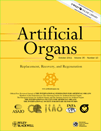Electrocardiogram-Synchronized Rotational Speed Change Mode in Rotary Pumps Could Improve Pulsatility
Presented in part at the XXXVII Meeting of the European Society for Artificial Organs held 8–12 September 2010 in Skopje, Macedonia.
Abstract
Continuous-flow left ventricular assist devices (LVADs) have greatly improved the prognosis of patients with end-stage heart failure, even if continuous flow is different from physiological flow in that it has less pulsatility. A novel pump controller of continuous-flow LVADs has been developed, which can change its rotational speed (RS) in synchronization with the native cardiac cycle, and we speculated that pulsatile mode, which increases RS just in the systolic phase, can create more pulsatility than the current system with constant RS does. The purpose of the present study is to evaluate the effect of this pulsatile mode of continuous-flow LVADs on pulsatility in in vivo settings. Experiments were performed on eight adult goats (61.7 ± 7.5 kg). A centrifugal pump, EVAHEART (Sun Medical Technology Research Corporation, Nagano, Japan), was installed by the apex drainage and the descending aortic perfusion. A pacing lead for the detection of ventricular electrocardiogram was sutured on the anterior wall of the right ventricle. In the present study, we compared pulse pressure or other parameters in the following three conditions, including Circuit-Clamp (i.e., no pump support), Continuous mode (constant RS), and Pulsatile mode (increase RS in systole). Assist rate was calculated by dividing pump flow (PF) by the sum of PF and ascending aortic flow (AoF). In continuous and pulsatile modes, these assist rates were adjusted around 80–90%. The following three parameters were used to evaluate pulsatility, including pulse pressure, dp/dt of aortic pressure (AoP), and energy equivalent pulse pressure (EEP = (∫PF*AoP dt)/(∫PF dt), mm Hg). The percent difference between EEP and mean AoP is used as an indicator of pulsatility, and normally it is around 10% of mean AoP in physiological pulse. Both pulse pressure and mean dp/dt max were decreased in continuous mode compared with clamp condition, while those were regained by pulsatile mode nearly to clamp condition (pulse pressure, clamp/continuous/pulsatile, 25.0 ± 7.6/11.7 ± 6.4/22.6 ± 9.8 mm Hg, mean dp/dt max, 481.9 ± 207.6/75.6 ± 36.2/351.1 ± 137.8 mm Hg/s, respectively). In clamp condition, %EEP was 10% higher than mean AoP (P = 0.0078), while in continuous mode, %EEP was nearly equivalent to mean AoP (N.S.). In pulsatile mode, %EEP was 9% higher than mean AoP (P = 0.038). Our newly developed pulsatile mode of continuous-flow LVADs can produce pulsatility comparable to physiological pulsatile flow. Further investigation on the effect of this novel drive mode on organ perfusion is currently ongoing.




